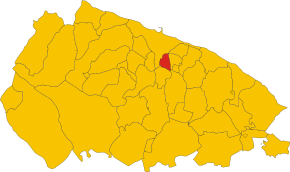Valenzano | |
|---|---|
| Comune di Valenzano | |
| Coordinates: 41°3′N 16°53′E / 41.050°N 16.883°E | |
| Country | Italy |
| Region | |
| Metropolitan city | Bari (BA) |
| Frazioni | San Lorenzo |
| Government | |
| • Mayor | Giampaolo Romanazzi |
| Area | |
| • Total | 15 km2 (6 sq mi) |
| Elevation | 85 m (279 ft) |
| Population (31 December 2010)[2] | |
| • Total | 18,305 |
| • Density | 1,200/km2 (3,200/sq mi) |
| Demonym | Valenzanesi |
| Time zone | UTC+1 (CET) |
| • Summer (DST) | UTC+2 (CEST) |
| Postal code | 70010 |
| Dialing code | 080 |
| ISTAT code | 072048 |
| Patron saint | St Roch, St Anthony of Padua |
| Saint day | 15–16–17 August (St. Roch) 13 June (St. Anthony) |
| Website | Official website |

Valenzano (Barese: Valzàne) is a town and comune in the Metropolitan City of Bari, in Apulia, Italy. It is home to several centers of scientific research, including Tecnopolis, one of the biggest of the Southern Italy in addition to The Mediterranean Agronomic Institute of Bari (IAMB) part of the International Centre for Advanced Mediterranean Agronomic Studies (CIHEAM). Valenzano is the seat of the "Antonio de Viti de Marco" Technical, Economic and Technological Institute (among which the Environmental Biotechnology specialization, established in the 2014-15 school year, stands out).
Sights include the All Saints' Church, a former 11th century abbey, and the late Renaissance church of St Roch. The baronial castle was reconstructed in 1870.
History
[edit]According to medieval historian Bonaventura da Lama, Valenzano was founded by a Greek man, named Valentinian or Valentian, who arrived in Apulia in the 8th-9th century escaping an invasion of Saracens. Historically, the area was inhabited in prehistoric and early historic times (up to 4th century BC) by the Peucetii, of Illyrian origins, as testified by funerary findings.
References
[edit]- ^ "Superficie di Comuni Province e Regioni italiane al 9 ottobre 2011". Italian National Institute of Statistics. Retrieved 16 March 2019.
- ^ Population from ISTAT
External links
[edit]





Well, that’s interesting to know that Psilotum nudum are known as whisk ferns. Psilotum nudum is the commoner species of the two. While the P. flaccidum is a rare species and is found in the tropical islands. Both the species are usually epiphytic in habit and grow upon tree ferns. These species may also be terrestrial and grow in humus or in the crevices of the rocks.
View the detailed Guide of Psilotum nudum: Detailed Study Of Psilotum Nudum (Whisk Fern), Classification, Anatomy, Reproduction